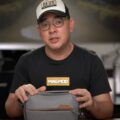Work Hours
Mon ~ Fri: 10:30 am - 6:30 pm
Sat: 10:30 am - 3:00 pm
Sundays, Holidays (Closed)
SCRUBBA FAQ
Here are our answers to some of our most frequently asked questions

How does the Scrubba™ wash bag work?
The Scrubba™ wash bag works on the same principle as an old-fashion washboard. Clothing is cleaned by rubbing them against the washboard. As opposed to an old-fashion washboard, the Scrubba™ wash bag is lightweight, compact and self-contained (you no longer need a bucket or basin). Furthermore, the Scrubba™ wash bag can mimimise exposure of the user to cleaning materials.
How much clothing can be washed at once?
Generally, the Scrubba™ wash bag is effective at cleaning a couple of T-shirts, a couple of pairs of jocks and a couple of pairs of socks at once (e.g. 2 days worth of summer clothes). While the Scrubba™ wash bag can hold more clothing, the washing efficiency may be reduced if too much clothing is added.
Can the Scrubba™ wash bag be used on all clothing?
The Scrubba™ wash bag can be used on most forms of clothing. While clothing made of thick materials such as denim jeans may be washed in the Scrubba™ wash bag, it may be necessary to open the bag and rotate the jeans to ensure sufficient contact between the whole jeans and the washboard. Care needs to be taken for clothing with zips or buckles, which could potentially damage the internal coating of the Scrubba™ wash bag.
Will the Scrubba™ wash bag damage my clothing?
Tests have shown that the Scrubba wash bag is gentler on clothing than washing machines. However, all washing techniques cause some wear on clothes. Users should always follow the washing instructions on their clothing. For delicate items, we recommend gently rubbing the clothes against the internal washboard.
Can my Scrubba™ wash bag be repaired?
In most instances, yes. With repeated use over time, the inner waterproof lining of the Scrubba™ wash bag may wear thin (resulting in slight leakage) or may be punctured if clothing with zips or buckles is washed vigorously. Repair to either of these is simpler than repairing a punctured bicycle tyre. Simply apply a flexible glue (e.g. PVC pool repair glue – available from most hardware stores) over the puncture or site of leakage on the inside surface of the Scrubba™ wash bag and allow it to dry. Alternately, a bicycle tyre puncture repair kit (from your local bicycle store) or inflatable mattress/tent repair kit (most camping stores sell this) may be used.
What’s the quickest way to expel air from the Scrubba wash bag?

We know that the valve on the Scrubba wash bag is pretty small. The reason for this is to keep the Scrubba wash bag compact, light and flexible. However, this does mean that expelling a large amount of air through the valve can take some time. You can quicken the process by laying the bag down and gently pressing on it as shown in the image below to remove most of the air before you seal the bag. After sealing the bag you can get rid of any remaining excess air by opening and squeezing the valve.
What is the capacity of the Scrubba™ wash bag?
The total volume of the Scrubba wash bag (regular) is around 13L (~3 gal). However, as the washing method requires you to seal the bag and rub the clothes against the washboard from the outside, the optimal working volume is around 3-4L (~1gal). We now have markings on the front of the Scrubba bag to help you add the right amount of water and clothes.
How long does the Scrubba™ wash bag take to clean a load of clothing?
For most clothing, simply rubbing them against the washboard from outside the bag for 20-40 seconds is sufficient to remove oils, dirt and odour from the clothing. For a machine quality wash, rub the clothes for 3 minutes and use a quality laundry liquid. For stubborn stains, the clothing may be rubbed for longer and/or the clothing may be allowed to soak in the Scrubba™ wash bag for 2-3 hours. If soaking clothing in the Scrubba™ wash bag, ensure the Scrubba™ wash bag is stored upright (e.g. seal facing upwards) to prevent water wicking through the seal.
Can I use hot water in the Scrubba™ wash bag?
Due to the waterproof lining in the bag, we recommend that water no hotter than 50°C (122°F) be used. Warm water (e.g. 30°C – 50°C or 85°F – 122°F ) can assist the washing process. Simply put, if it is too hot to hold your hands in, the water is too hot for the Scrubba™ wash bag.
What cleaning product should be used with the Scrubba™ wash bag?
A variety of detergents have been tested in the Scrubba wash bag with success. We’ve found the use of liquid detergents to be more efficient due to the extra time it takes to dissolve solid detergents (powders, leaves, etc.). Using a liquid enables active suds immediately, reducing the overall time required for rubbing out a wash. We are conscious of the fact that every traveler has different priorities. For some travelers, weight is the most important factor in packing, so a single product that can perform multiple tasks is beneficial. A small dollop of 3-in-1 bodywash-shampoo-shave liquid may be used in the Scrubba wash bag and we have found this to work well in refreshing clothes.
If you don’t mind carrying extra products, then packing a very small (~25-30ml) bottle of washing liquid (e.g. Ariel, the like) is a good idea when traveling. Washing liquids are generally the most efficient for cleaning your clothes, as they are purpose designed for removing oils and dirt from fabrics. You really only need to use the smallest amount (probably a few ml per bag load) as washing liquids are generally highly concentrated.
For environmentally conscious travelers, there are a number of bio-washing liquids on the market (often released by outdoor brands and available at camping stores) that are better for the environment (e.g. phosphate free). These probably fall somewhere between using bodywash/shampoo and a washing liquid in efficiency but are much better for use in the back country.
You can test for quantities of different cleaning products in the Scrubba wash bag by checking the amount of suds visible through the clear section of the bag. If you still have suds after 30 seconds of rubbing, then you can probably reduce the amount of product for the next batch. Optimizing the amount is not only better for the environment, but will also minimize the amount of rinsing required.
While the Scrubba wash bag has been made with a highly chemically resistant form of urethane, use of very harsh bleaches may reduce its longevity. We do not recommend soaking with such products in the Scrubba wash bag for prolonged periods.
How do I care for my Scrubba™ wash bag?
Your Scrubba wash bag will last much longer if you look after it.Following the instructions below will maximise the life-span of your Scrubba wash bag.
- Rinse and turn the Scrubba wash bag inside-out to dry after each use: While the Scrubba wash bag uses microbial and hydrolysis resistant polyether TPU, air drying the inside of the bag will help it last longer and make it more hygienic.
- Avoid exposure to heat or sunlight: Exposure to temperatures over 50°C (122°F) or sunlight can damage the inner and outer coatings of the Scrubba wash bag. Where possible dry the bag in the shade (it doesn’t take long).
- Take care when washing clothes with zips, buckles or other hard features: Wrapping the clothes to cover zips, buckles or other hard features can minimise damage to the Scrubba wash bag.
- Avoid sharp or abrasive surfaces: While the Scrubba wash bag is designed to tackle rough terrain, where possible select the least abrasive surface available to use the Scrubba wash bag on. Abrasive surfaces can accelerate the wear and tear of the Scrubba wash bag. As with all waterproof products, try to clear sharp twigs and other objects from area to avoid puncture.
Why isn’t there a loop for hanging the Scrubba wash bag to dry?
As we recommend inverting the Scrubba wash bag after use to dry, the loop would need to be added to the inside of the bag, which would affect the washing performance. When you invert the bag, you can make good use of the clips to hang the inverted bag to dry.
How do I reduce water wicking out of the seal?
While our fabric and the seams of the Scrubba wash bag are waterproof, the roll-down-and-clip closure can allow a small amount of water to wick through over time. This can be minimised by rolling the top down as tightly as possible and at least 4-5 times. When tightly rolled, water typically won’t wick through the top for at least 20 minutes, which should be a sufficient amount of time to perform a standard Scrubba wash. If you position the buckles of the roll-down-and-clip seal to face upwards (as shown in the image below), this will also reduce wicking.
How long will the Scrubba™ wash bag last?
This largely depends on how often you use the Scrubba™ wash bag, how rough you are with the Scrubba™ wash bag, and how well you following the instructions in our Care section above. Treated well, the Scrubba™ wash bag should last for hundreds of uses.
While the Scrubba wash bag is built to be durable, normal wear and tear will occur over time




